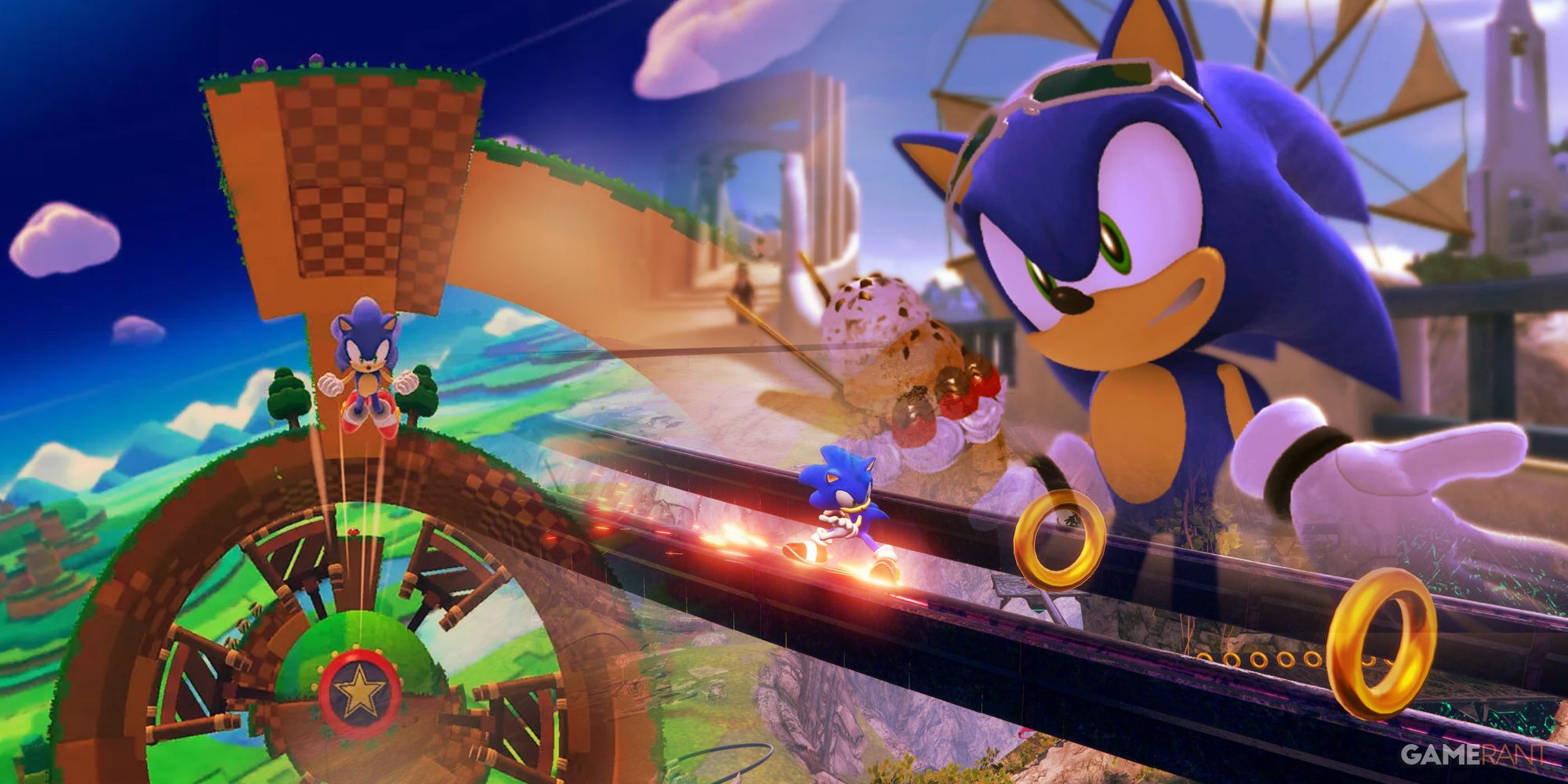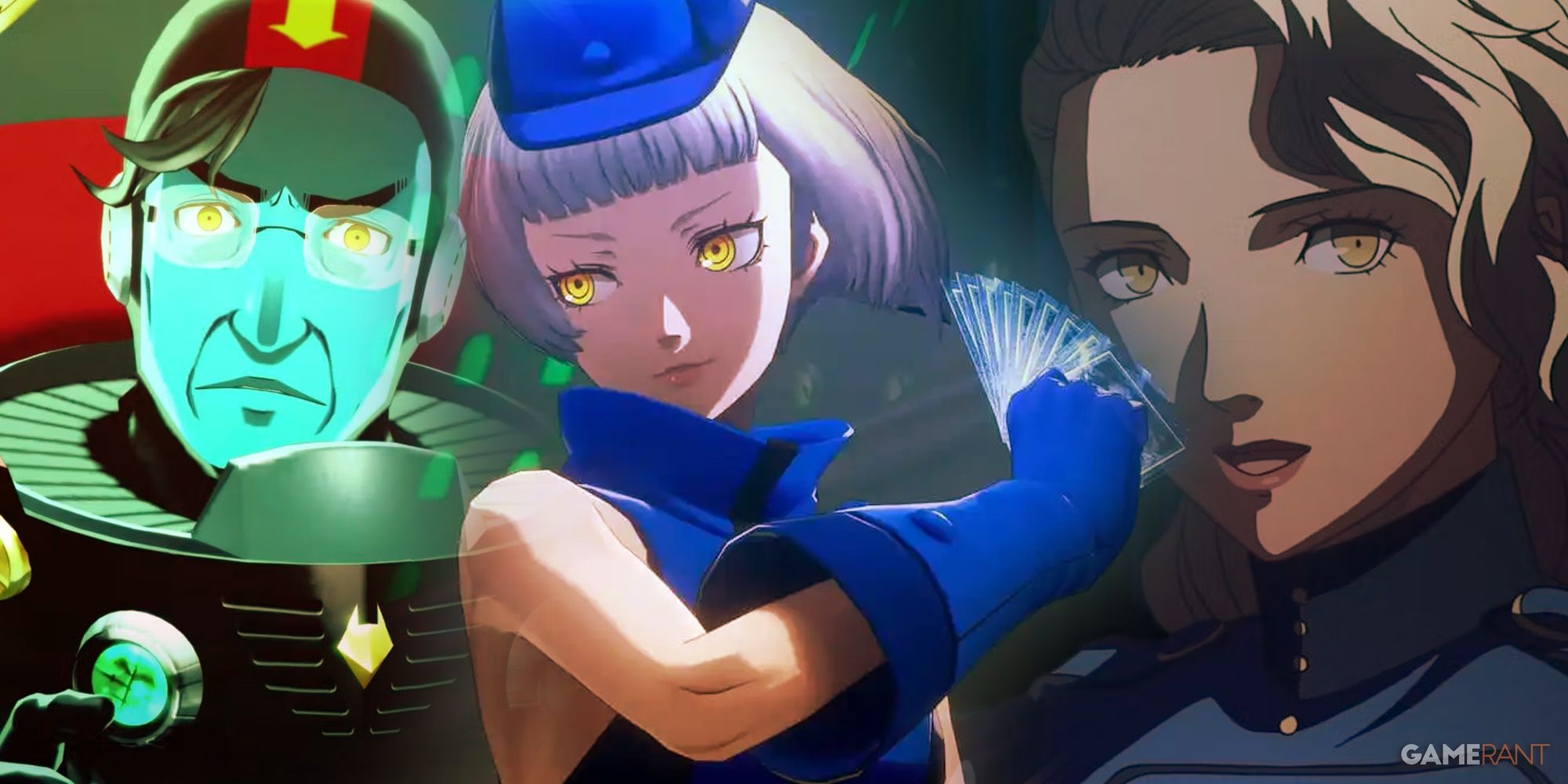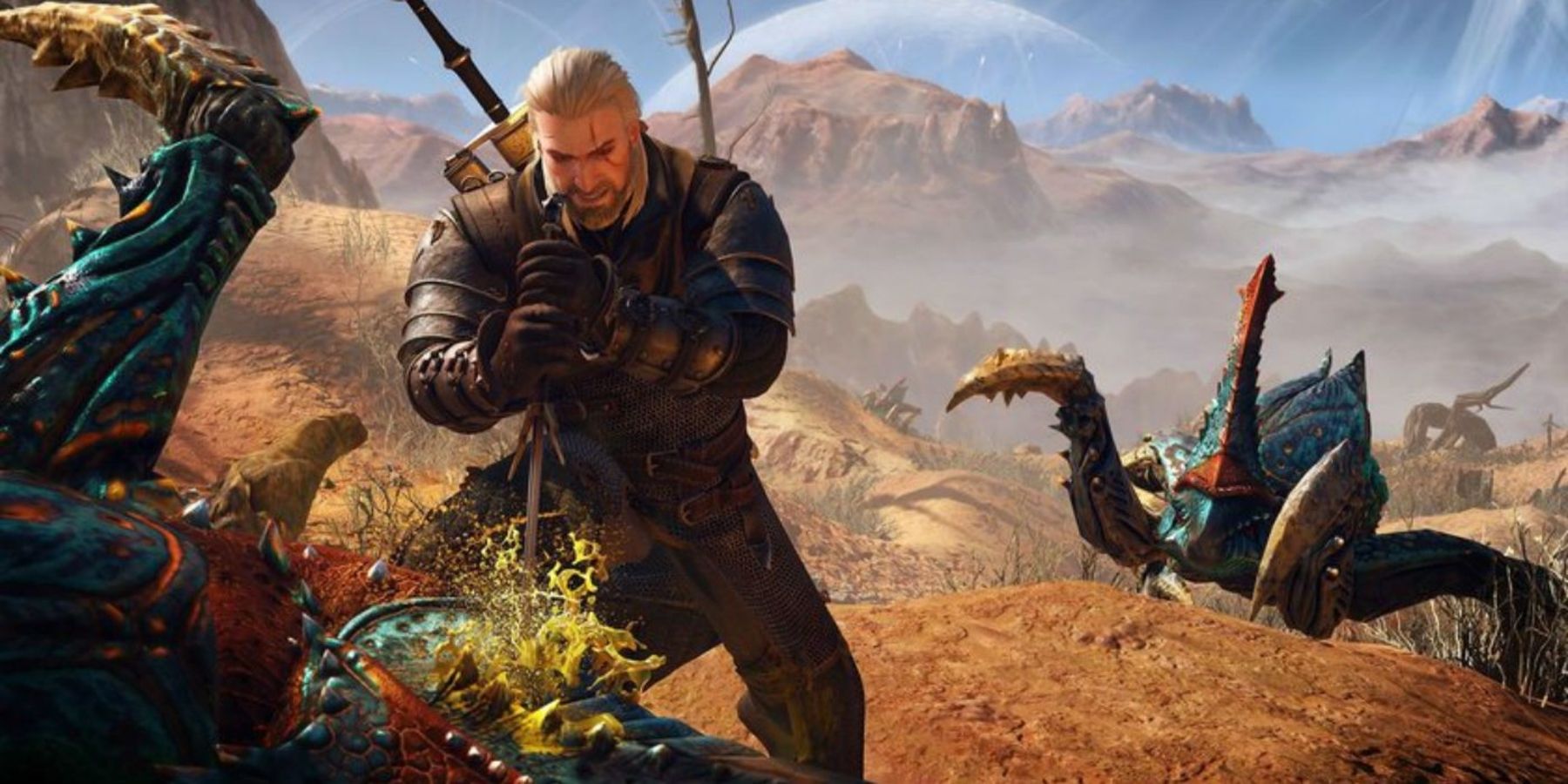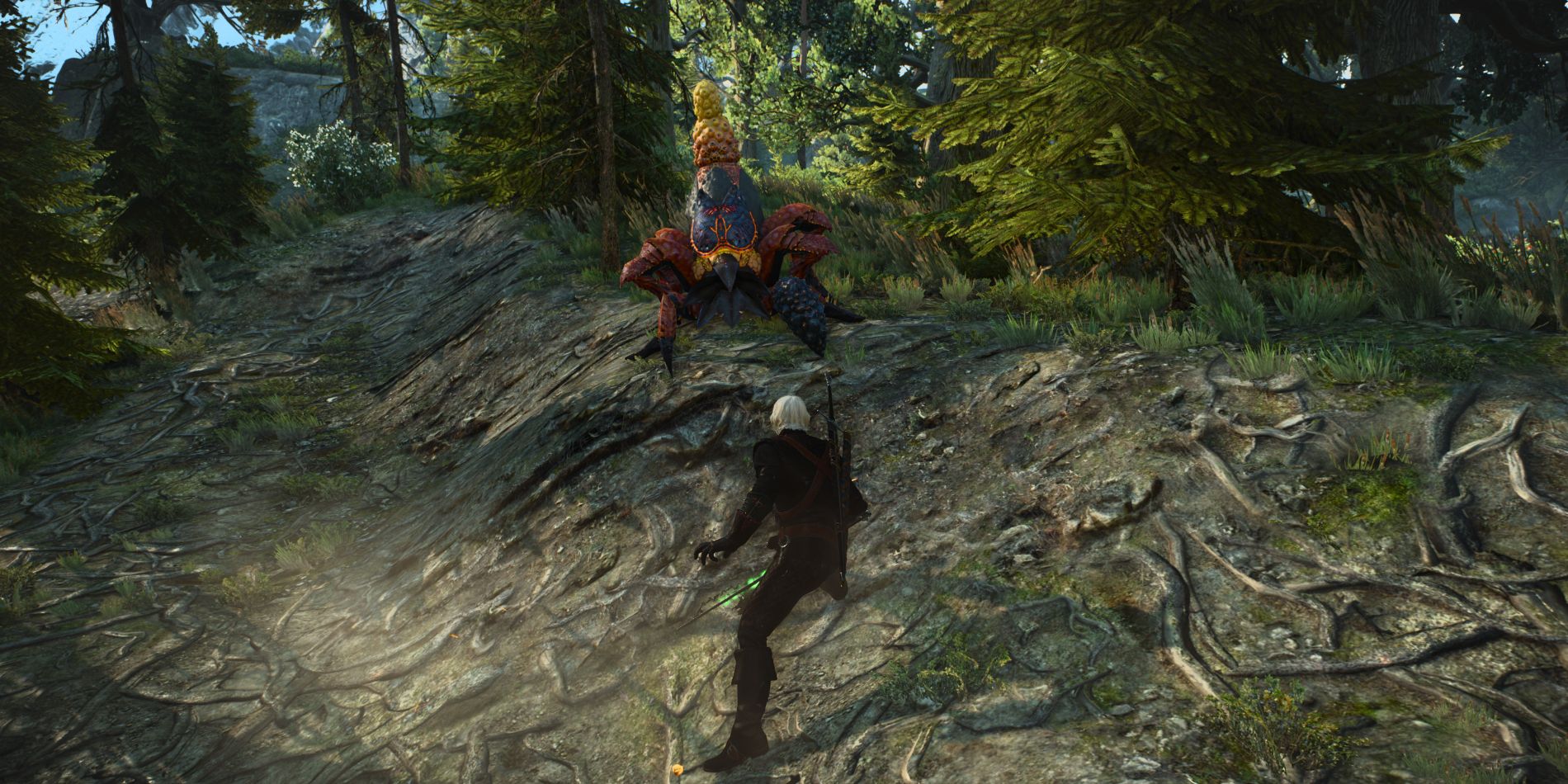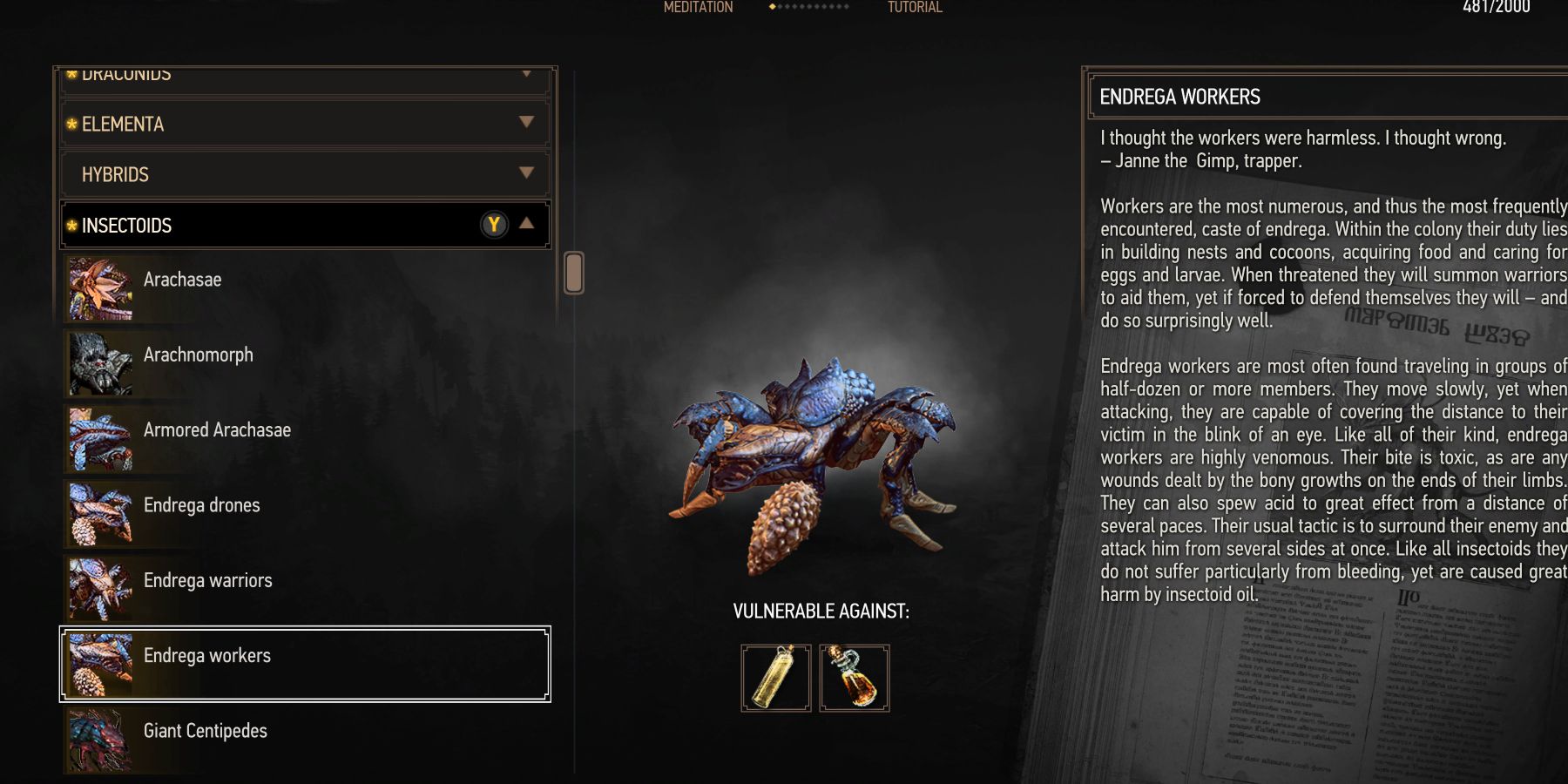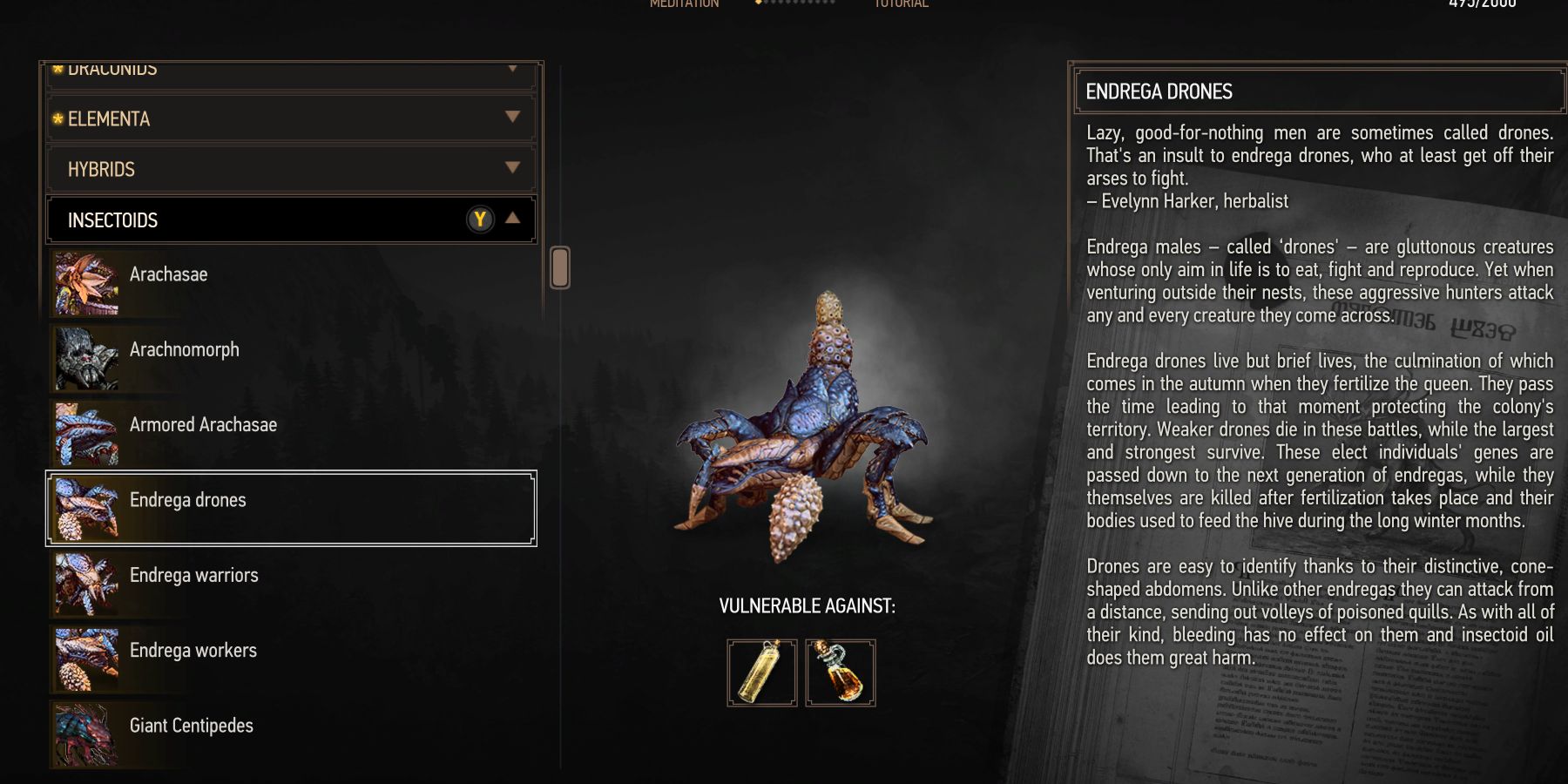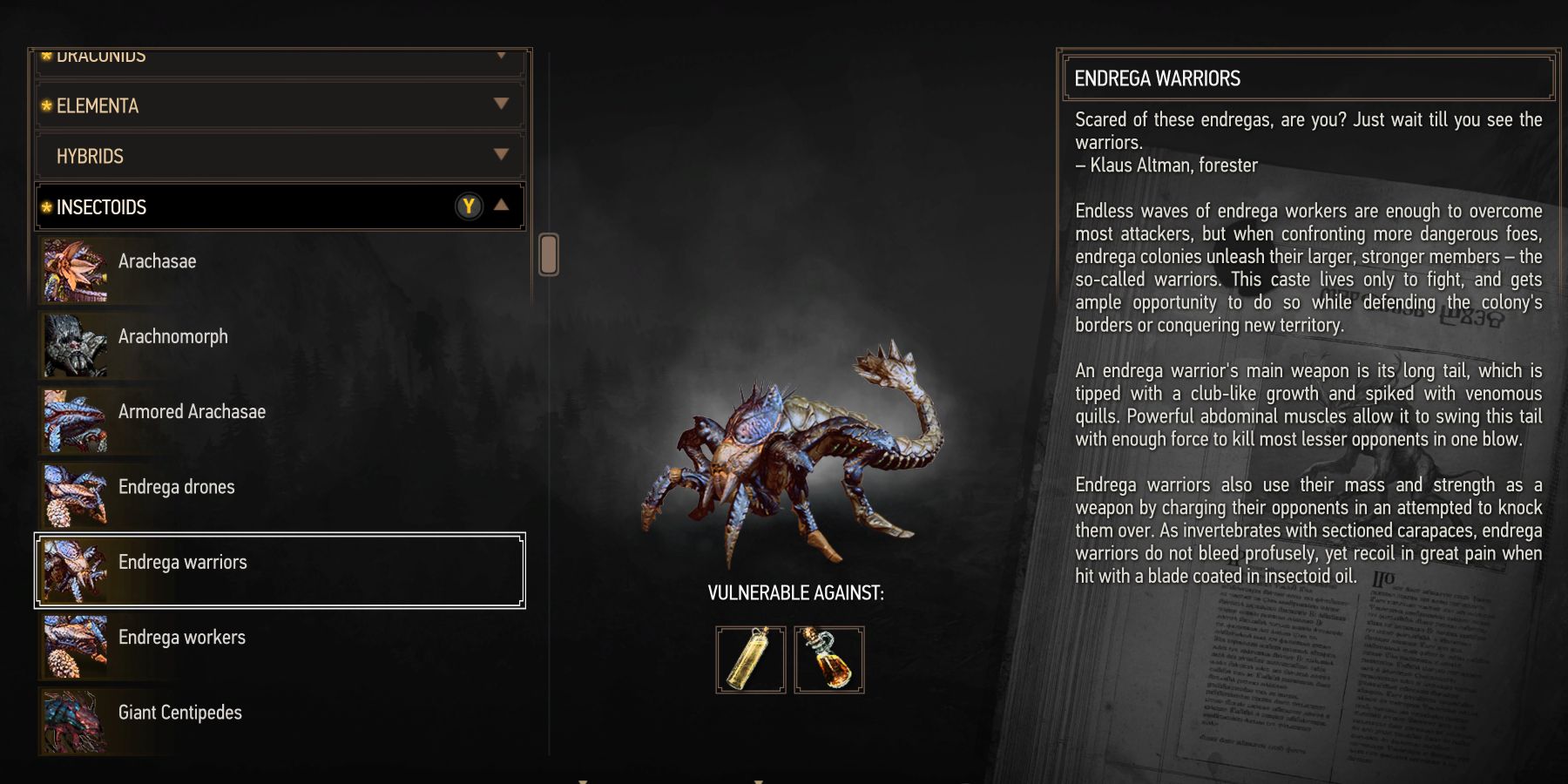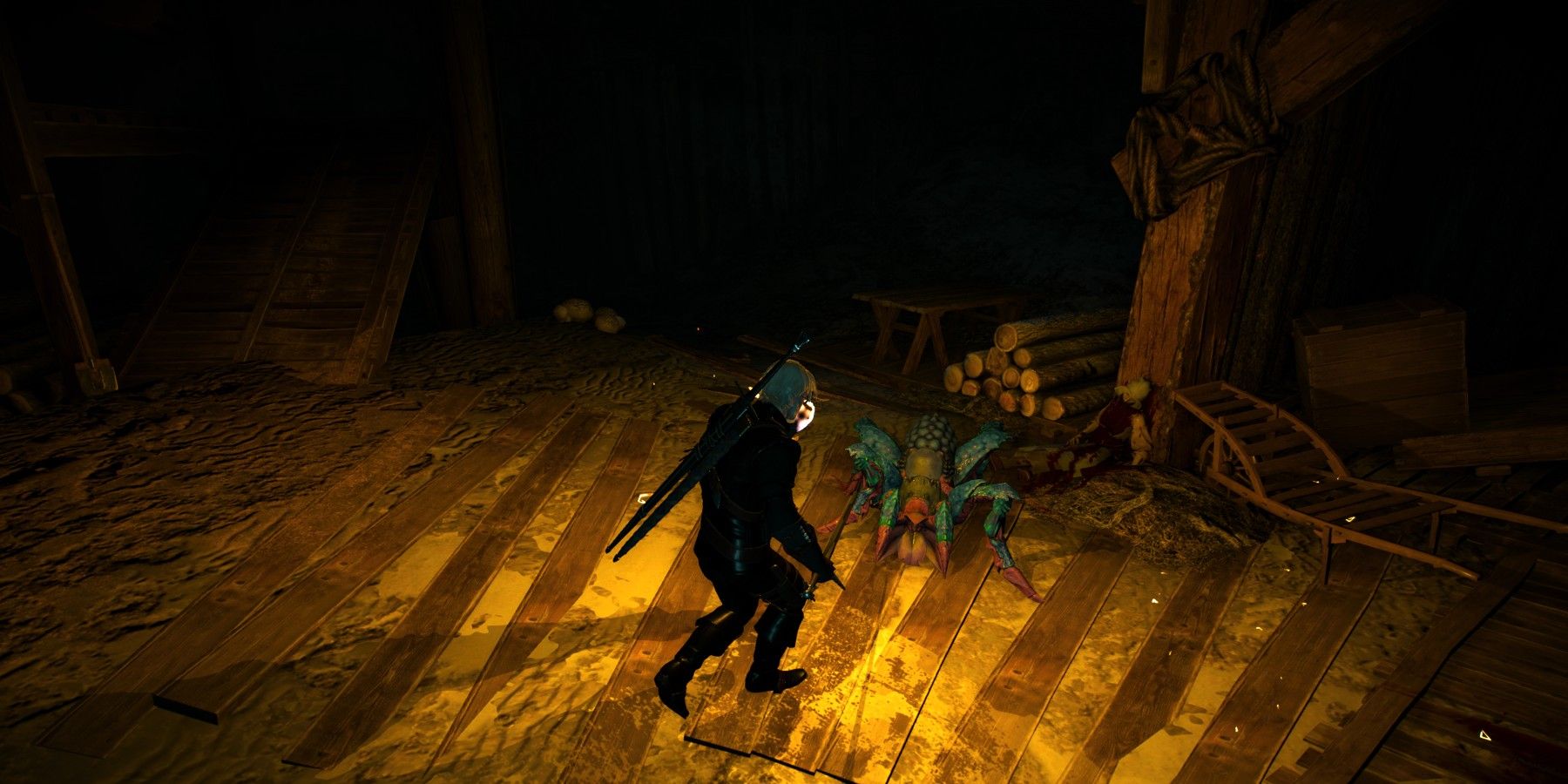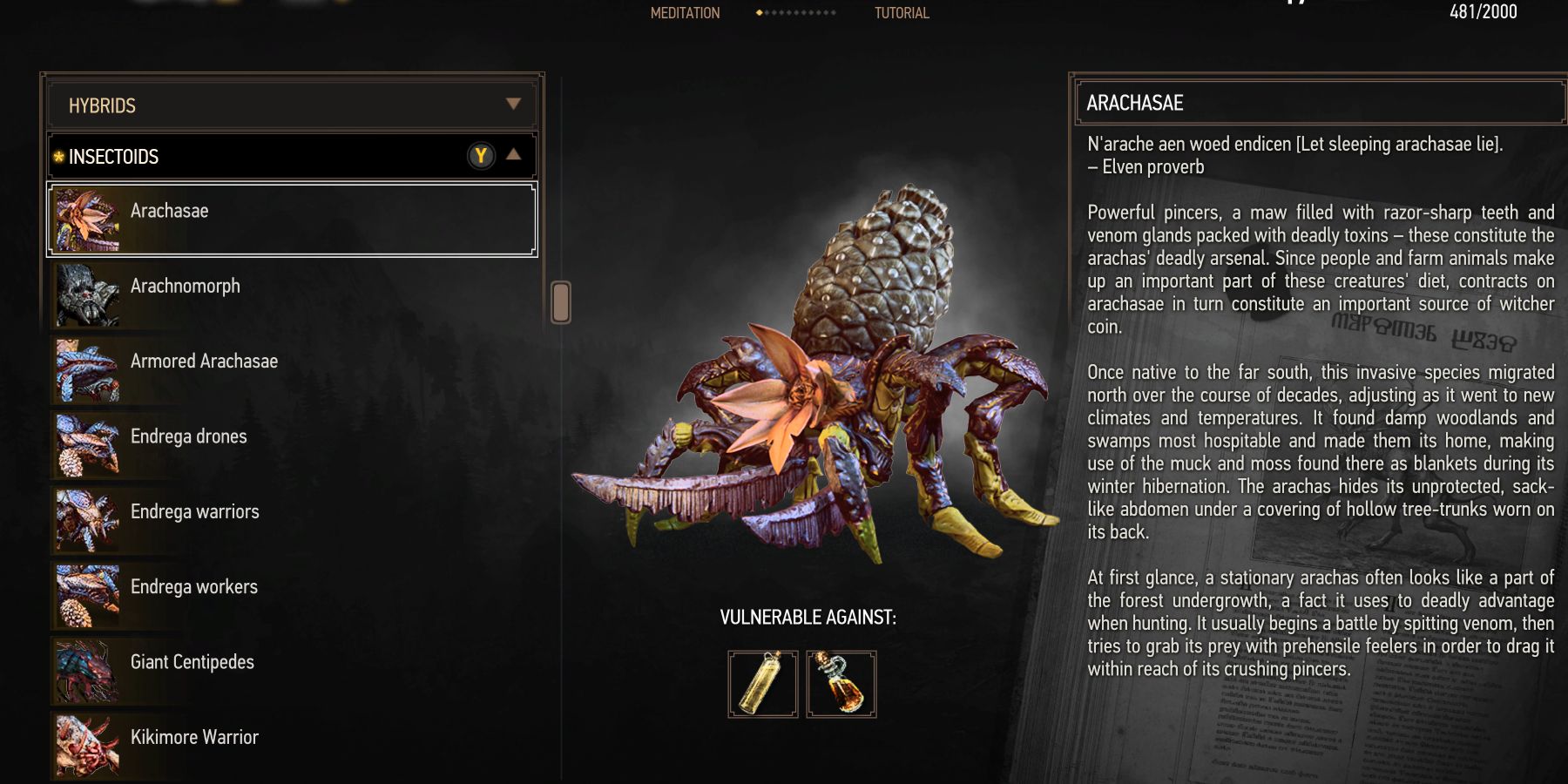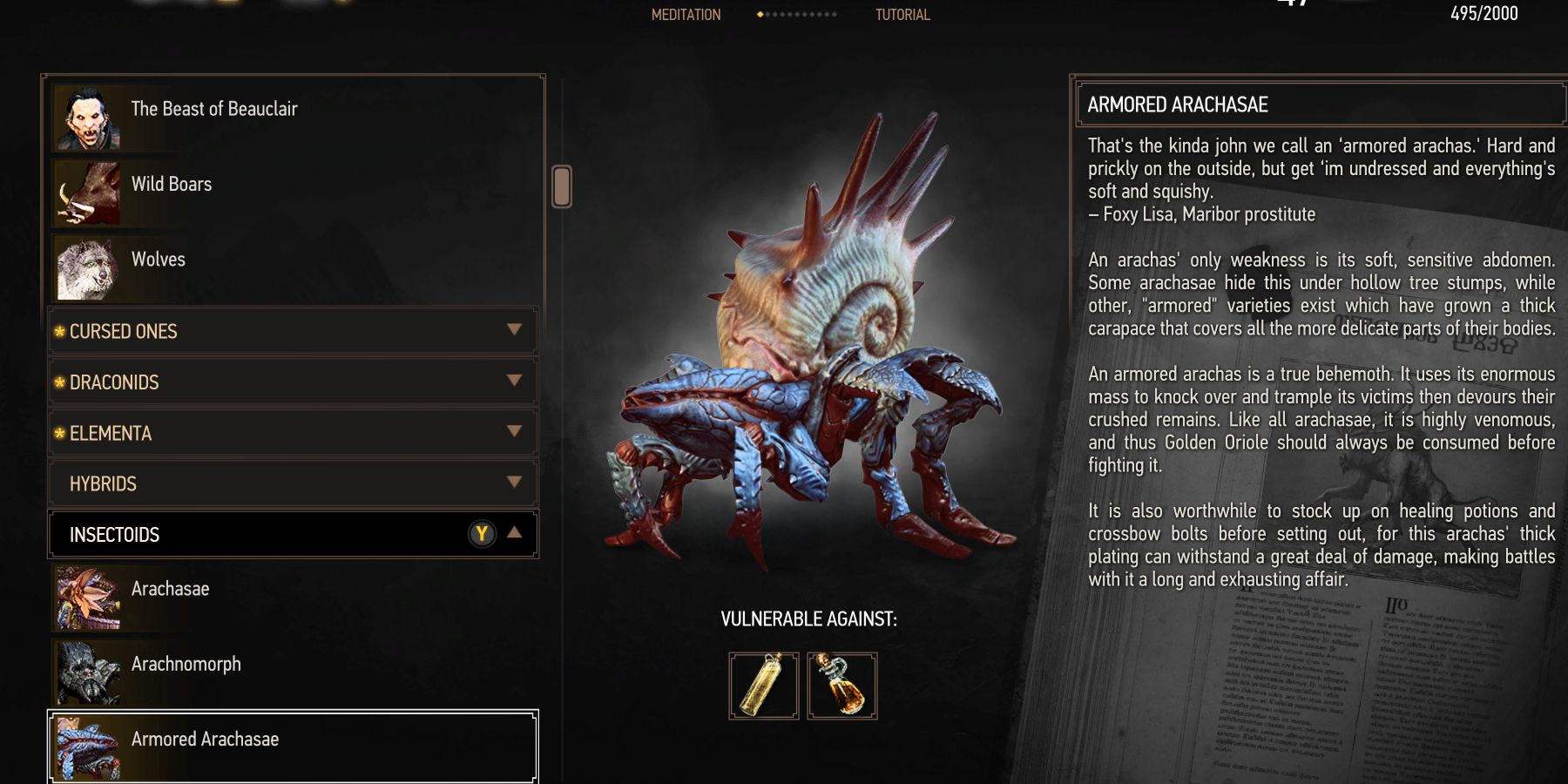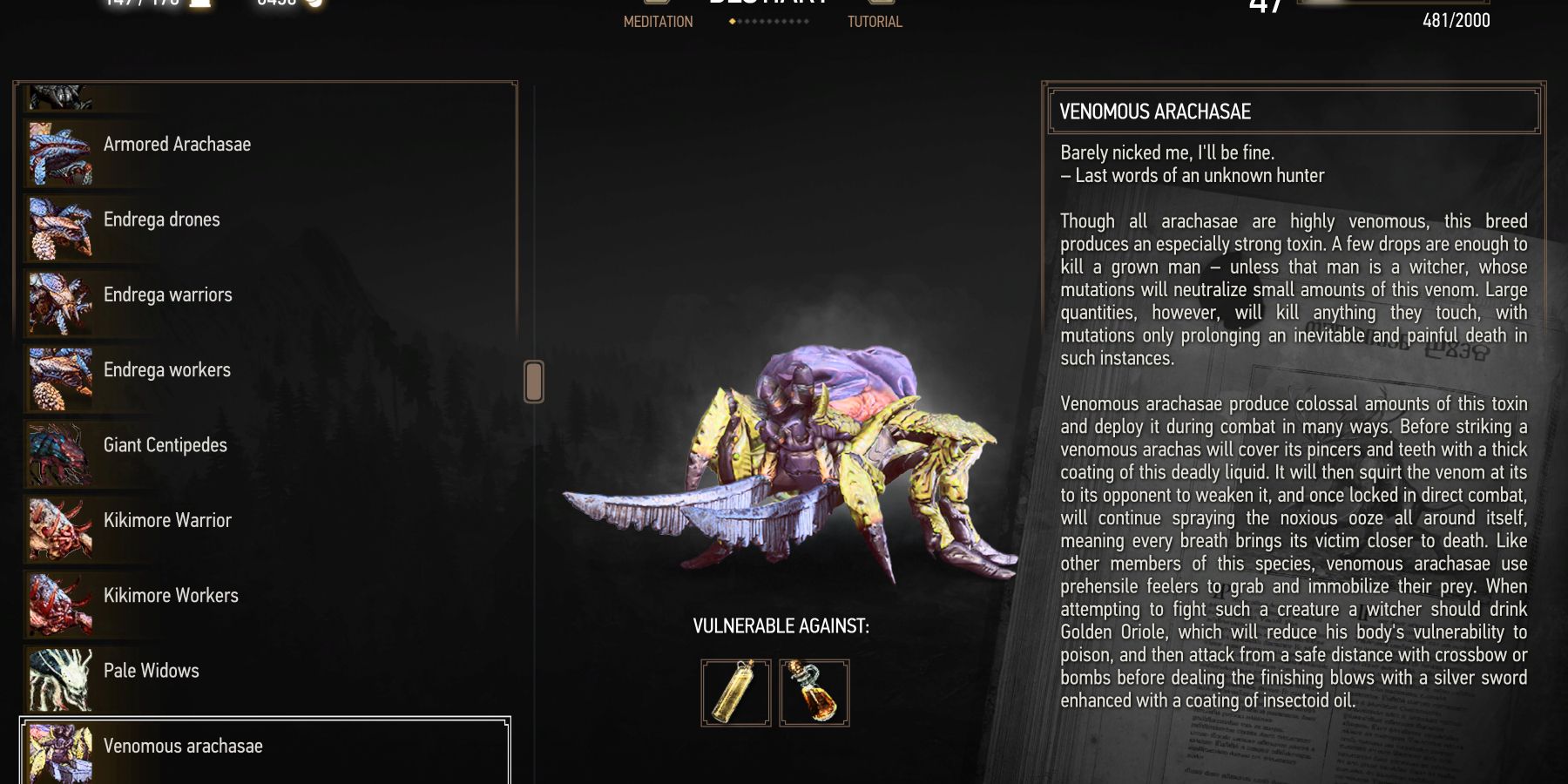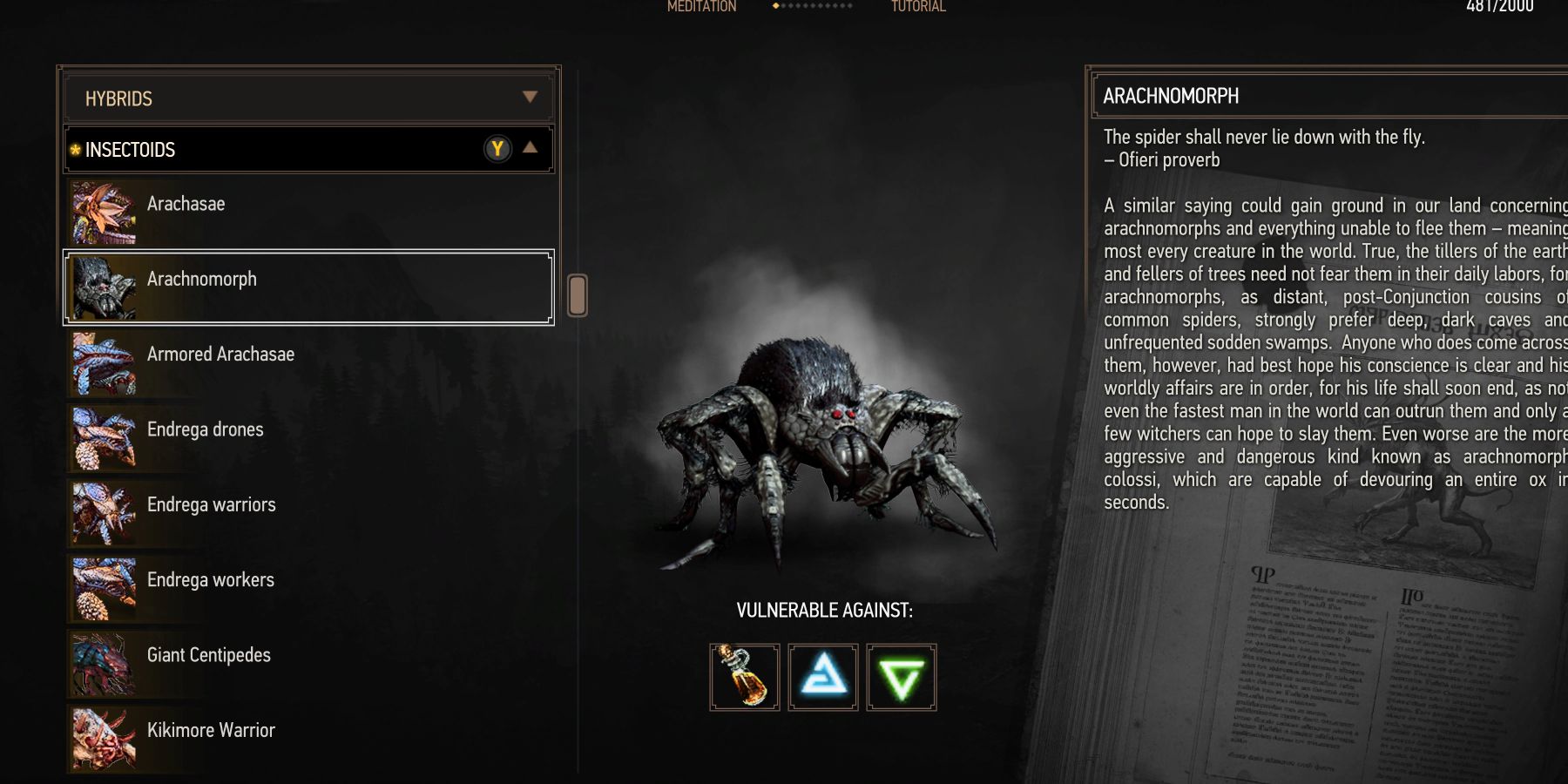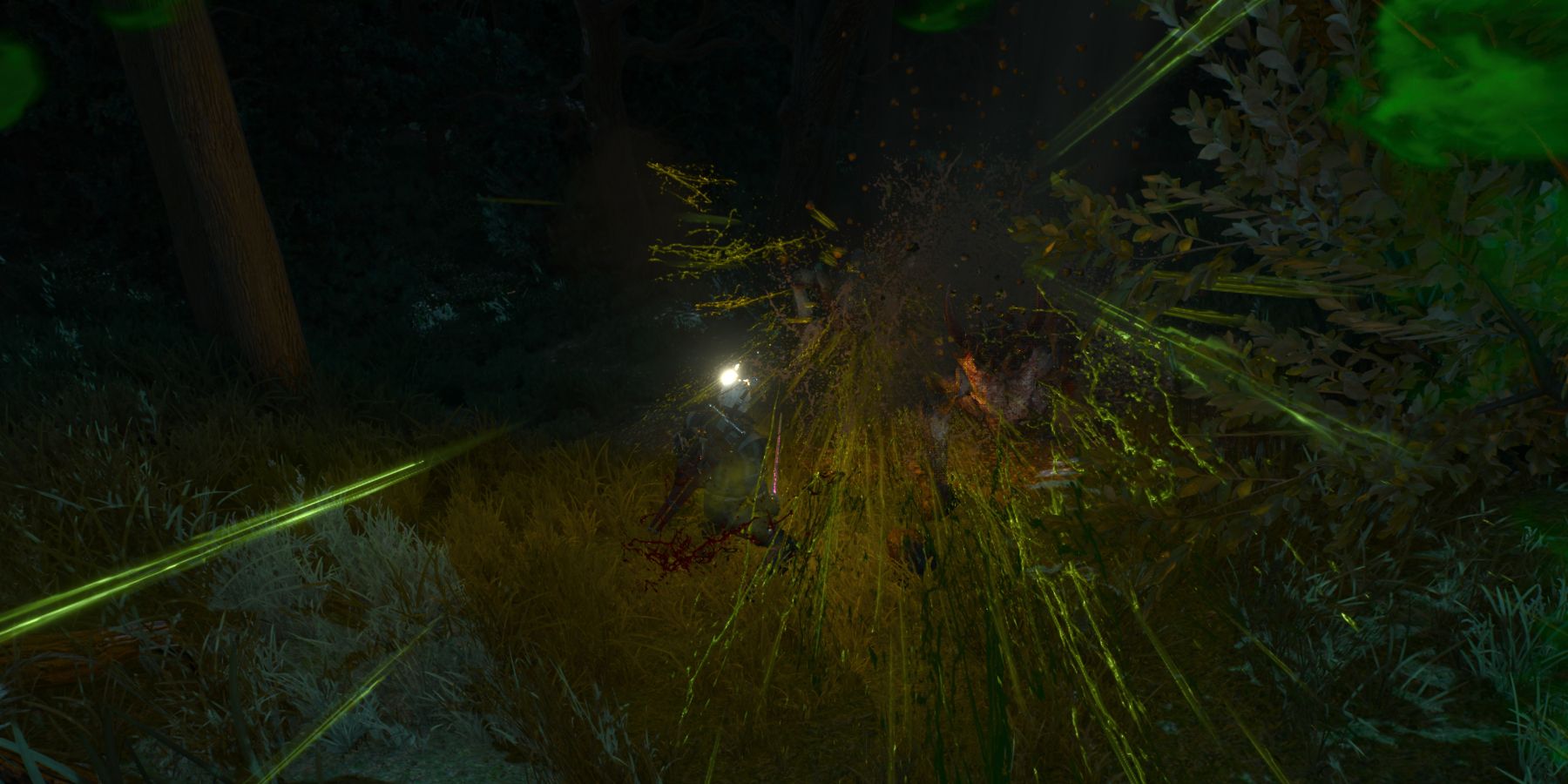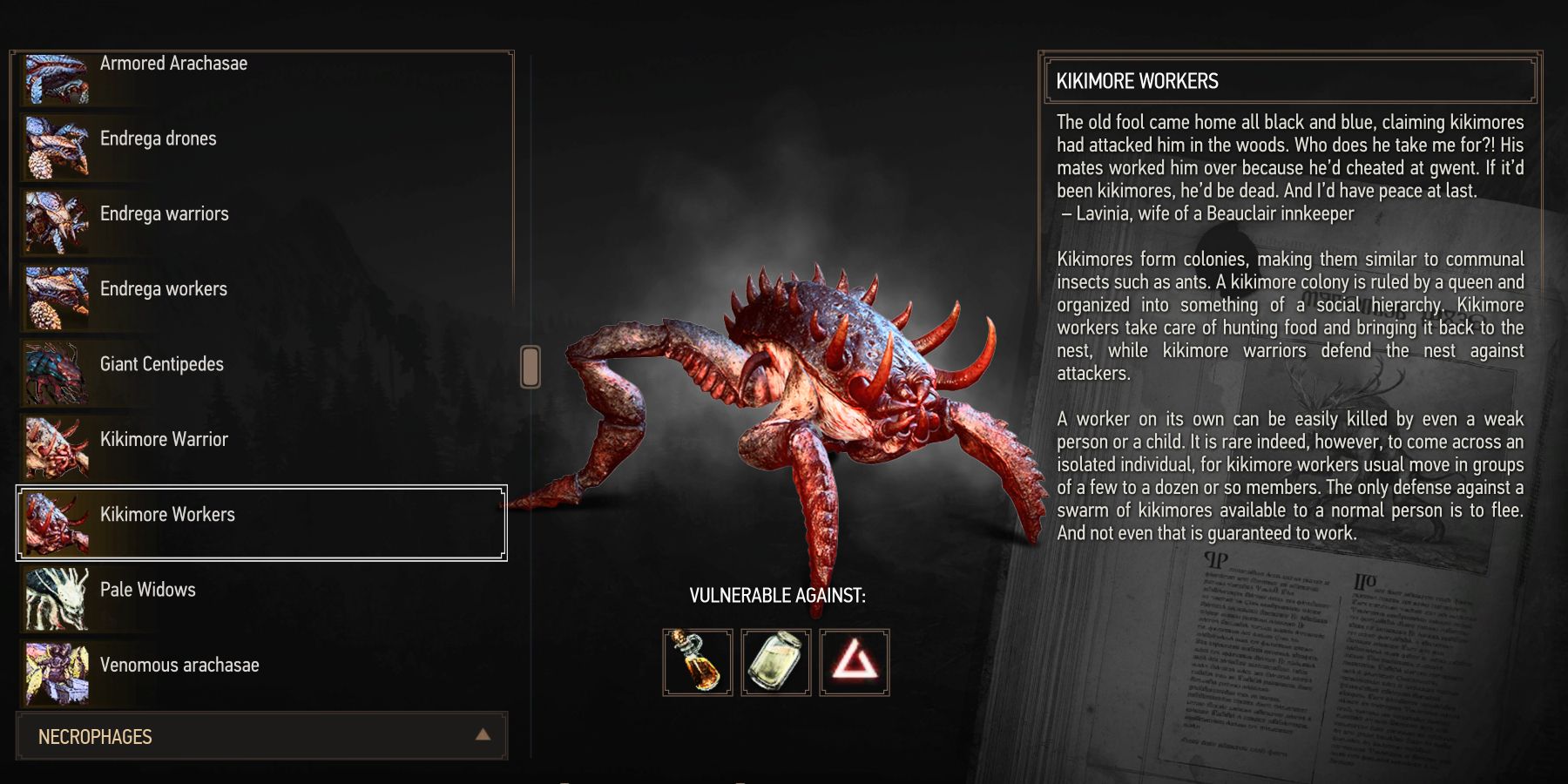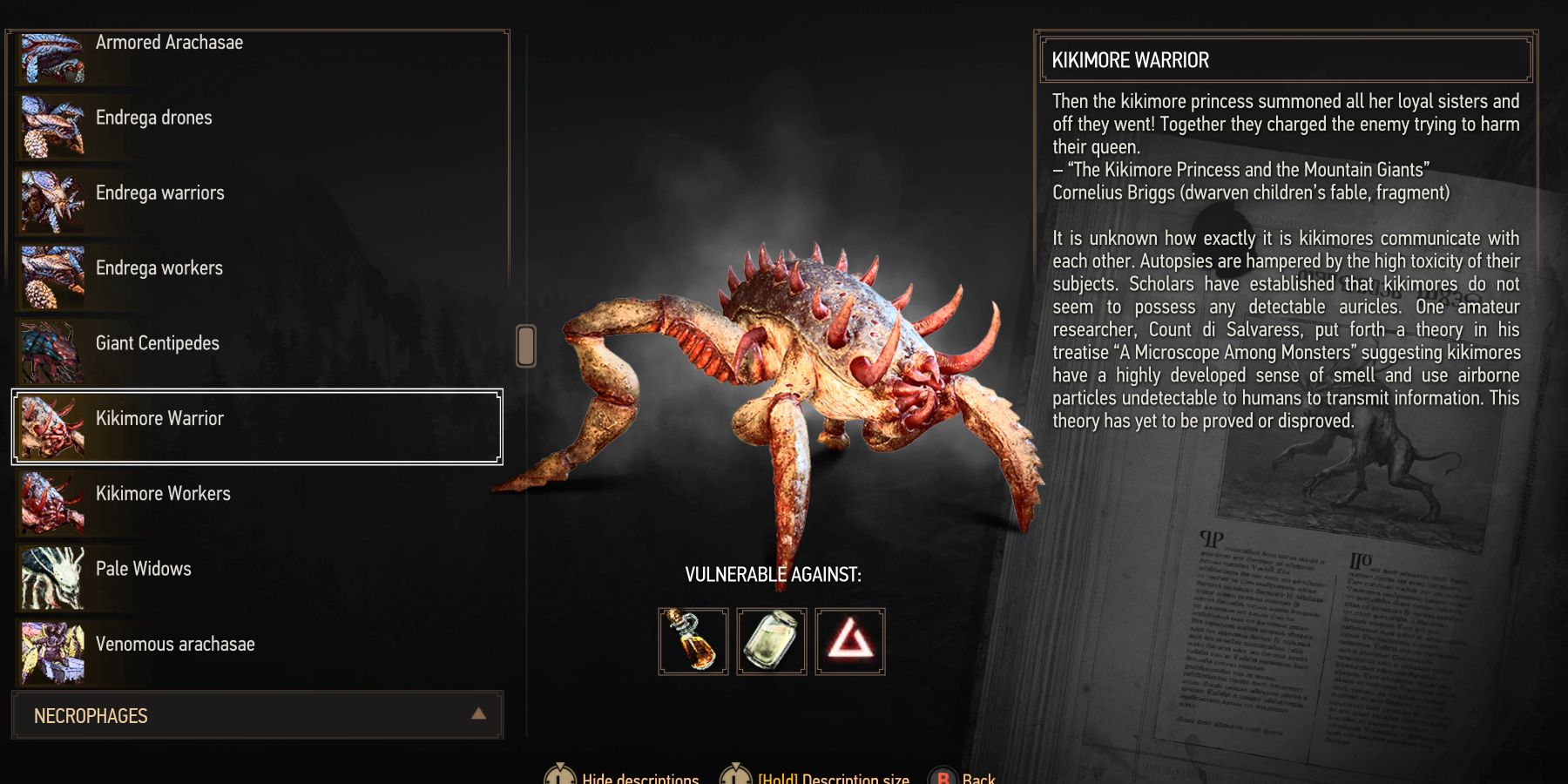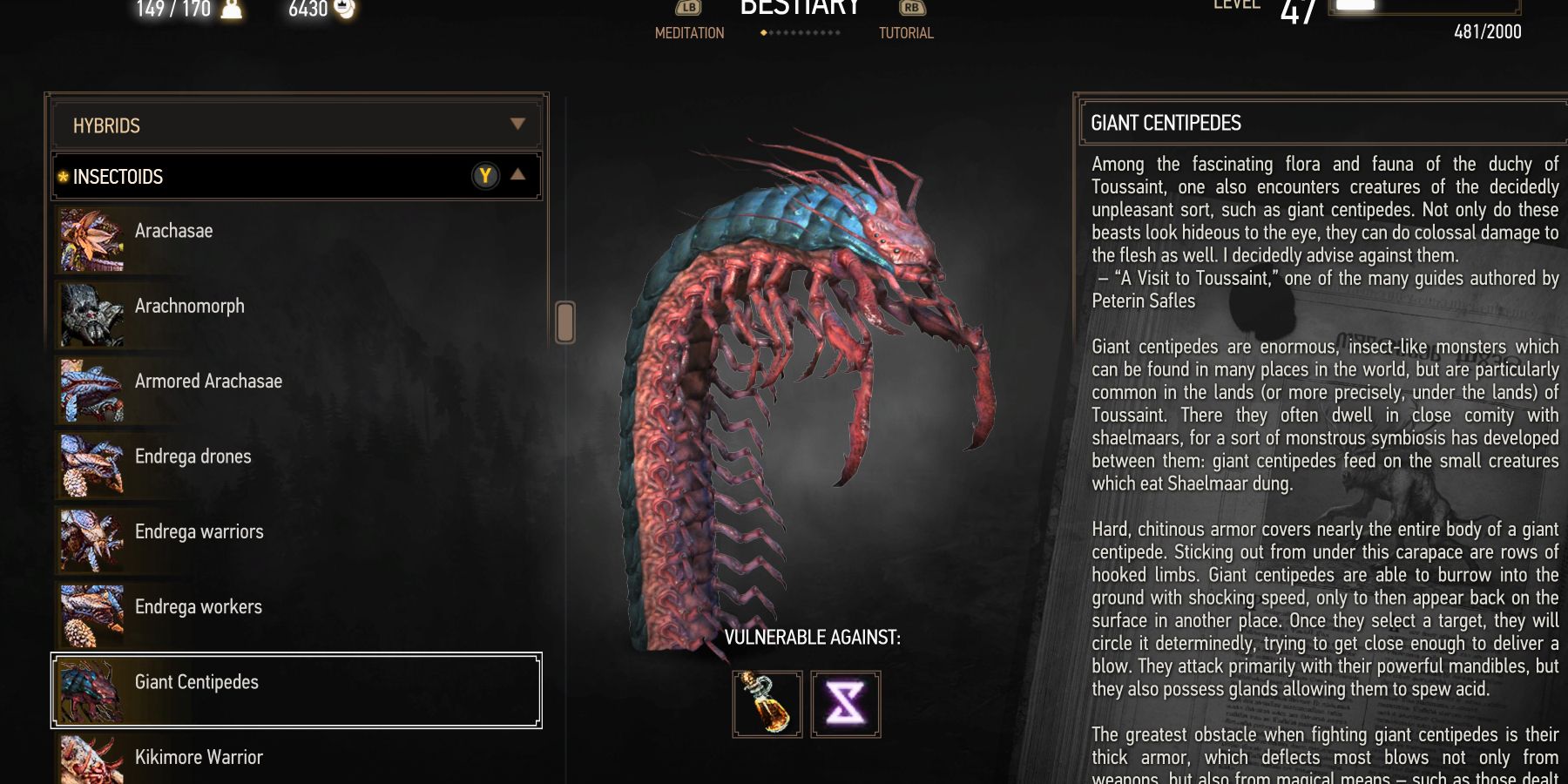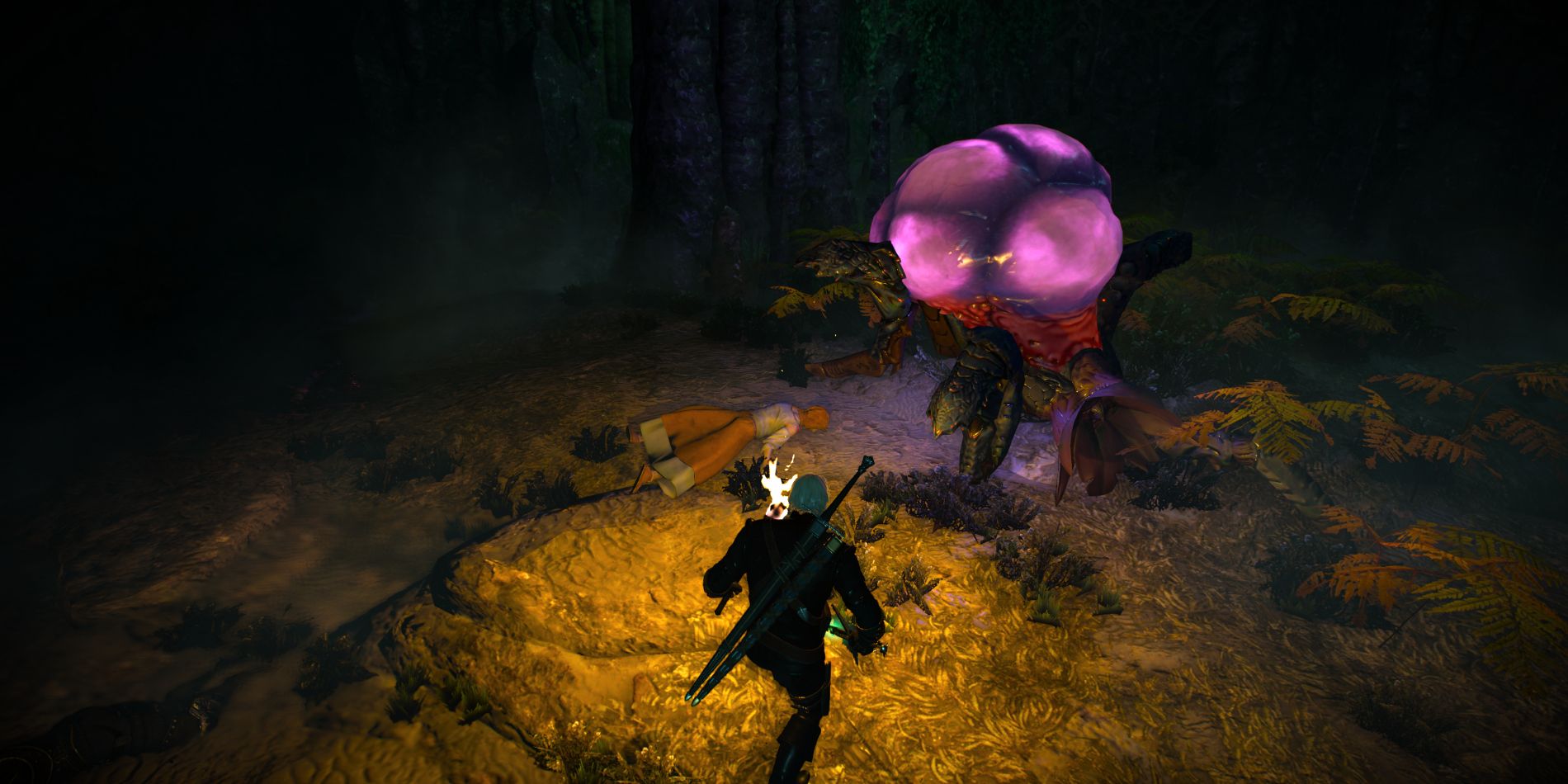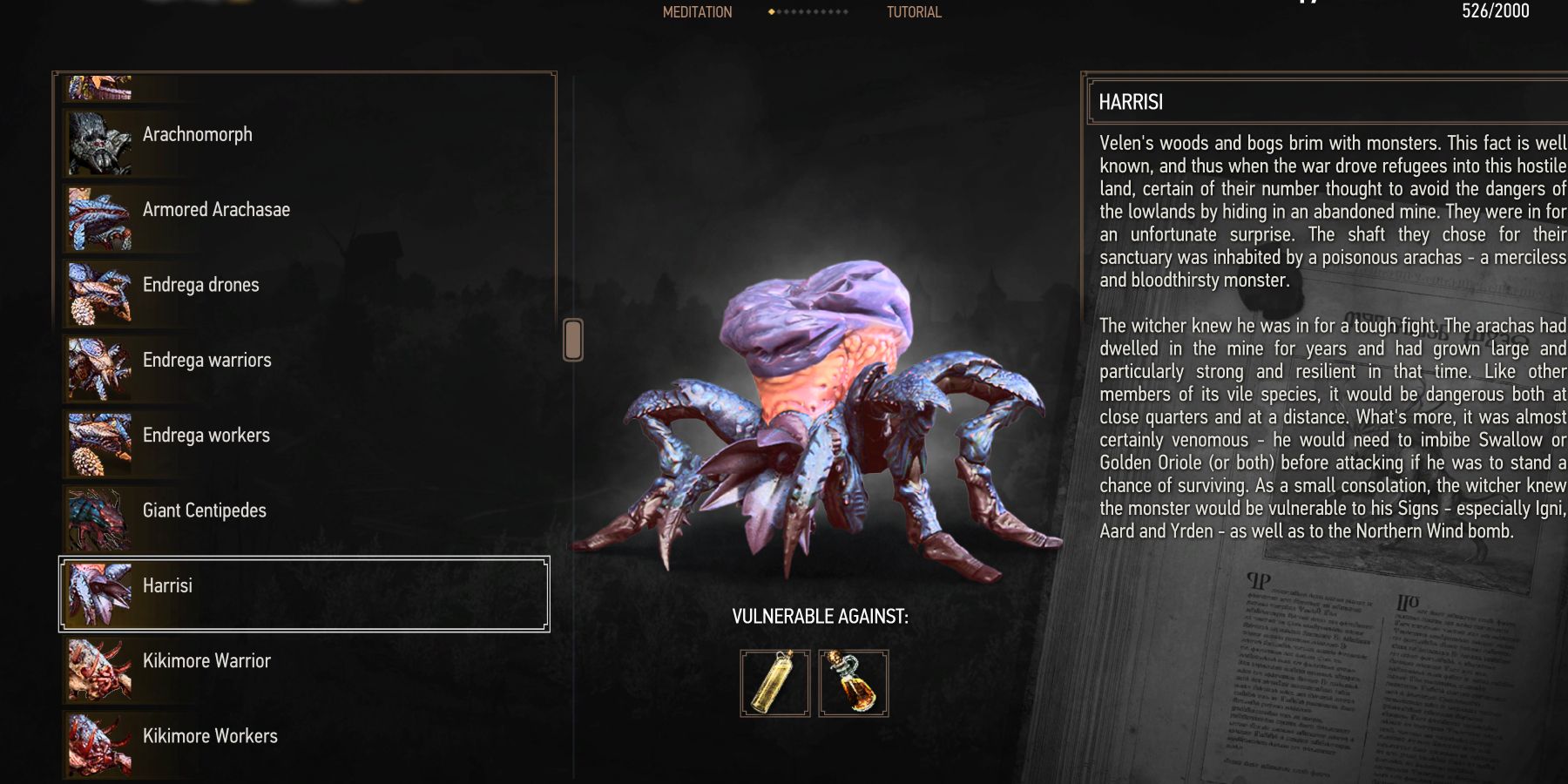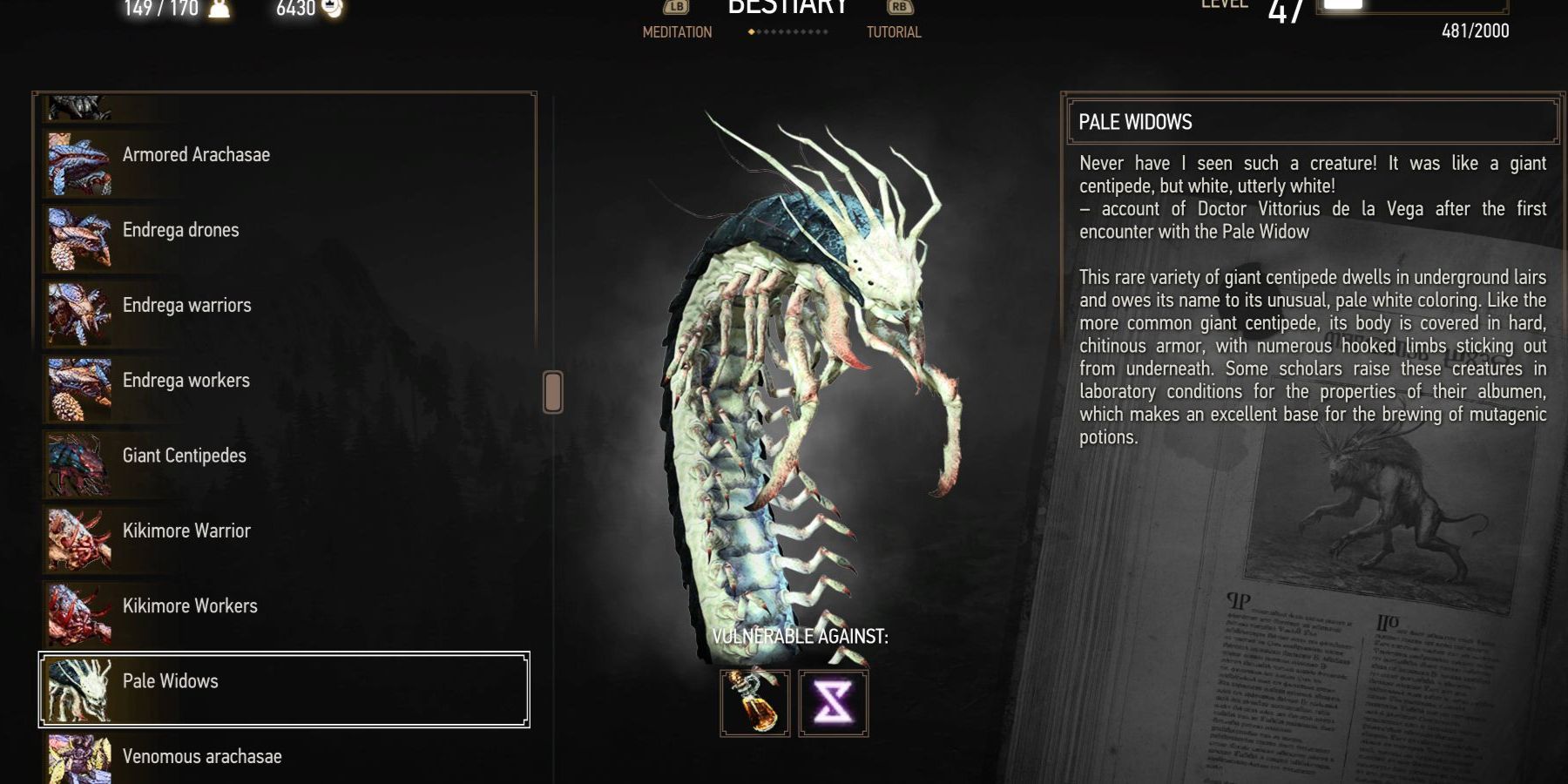Quick Links
The Witcher 3: Wild Hunt is filled to the brim with nearly every type of monstrosity imaginable. From diabolical demons to cantankerous trolls, it seems that Geralt of Rivia faces a new enemy with every step he takes. The Witcher's most formidable tool in these encounters is not just his swords, but also the intimate knowledge of a creature's strengths and weaknesses. It stands to reason that, as the list of evil men and dangerous monsters expands, so too does Geralt's need for critical information.
One of the most common enemy types that Geralt will encounter on his journey through The Witcher 3 is insectoids. These unsightly creatures can be found in almost every corner of the continent. The name insectoid covers a large family of creatures that include endrega, kikimore, arachasae, and giant centipedes. While each of the subspecies has several differences, they all share a resemblance to various arthropods of the natural world.
Remember, all insectoids are vulnerable to insectoid oil . Use it before fighting anything in this guide!
Endrega Variants
The Endrega is an extremely common creature that roams the forested areas of Geralt's world. The variants often form large packs and attack together.
Endrega Worker
- These are the most common form of endrega. Attack in large groups, though less aggressive than drones and warriors.
- Igni and Aard stun the workers, allowing for fast strikes.
- Drops: Venom extract, endrega embryo, endrega heart, lesser blue mutagen, lesser green mutagen, chitinous shell, monster saliva
Endrega Drone
- Easily identified by the bulb-shaped tip on its tail.
- The drones are far more dangerous than the workers. They have the ability to shoot poisoned quills from their tail. This special attack will be preceded by a tremble.
- Use golden oriole potion to mitigate poison effects.
- Yrden, Axii, Aard, and Igni are all effective at slowing or stunning the drone. Use this time to attack, but watch for poison attack.
- Drops: chitinous shell, lesser blue mutagen, lesser red mutagen, monster saliva, endrega armor plates.
Endrega Warrior
- By far the most aggressive variant. Distinguished by its long, spiked tail that is used as a poisoned cudgel.
- Capable of knocking Geralt off-balance with both a frontal charge and a tail whip. Dodging these attacks is the most effective counter.
- Attempting to stand still and continuously hack at the warrior is often ineffective and will result in being knocked back by a tail whip.
- Both Axii and Aard will stun the warrior, leaving them vulnerable to attack.
- Drops: Lesser blue mutagen, lesser green mutagen, chitinous shell, endrega heart, endrega armor plates, venom extract
Arachasae Variants
The Arachasae are creatures that are based on arachnid forms from the natural world. Varying greatly in appearance and threat level, these monsters can be found in the caves and forests of the world.
Arachasae
- These large spiders-like enemies can vary in form, some being large and bulbous while others are more streamlined and armored.
- Frontal assault is ineffective as the arachas can use front pincers to mitigate Geralt's attacks. Also capable of a massive counter-attack when Geralt is in front.
- Use Yrden to slow and Axii to stun.
- The arachas will shoot a ranged web attack to limit Geralt's movement. Attacks sustained in this state can be devastating.
- Use poison mitigating potions like golden oriole to counter the buildup from all attacks.
- Drops: Arachas eyes, chitinous shell, arachas venom, lesser red mutagen
Armored Arachasae
- The armored arachas have all the same characteristics as the basic arachas save for one key difference: a massive armored shell.
- This makes attacks from the side and back particularly problematic. The best approach is a "strike and run" strategy aimed at the vulnerable areas not covered by the shell.
- Yrden and Axii work well here as well, giving Geralt time to find openings to strike.
- Drops: Arachas eyes, chitinous shell
Venomous Arachasae
- The same tactics that work on the basic arachas will also work here.
- The key difference with the venomous arachas is a special attack that allows it to release a massive cloud of poison gas.
- Watch for the buildup to release, which is marked by a clear pause in movement, and a motion similar to taking in air. Once the cloud is released, the pouch on the back will empty. Pay attention to this pouch because the creature cannot use the attack again until it is full.
- Ranged attacks such as bombs and the crossbow allow Geralt to maintain distance, mitigating the threat of the poison cloud.
- Drops: Arachas mutagen, arachas eyes, arachas venom, chitinous shell
Arachnomorph
- Introduced in the Hearts of Stone DLC, these creatures are essentially large spiders.
- There are several size variants of this creature, though their behavior is similar across all sizes. They are mostly encountered in the caves and forests of northeastern Velen.
- Extremely aggressive, these spiders like to send their smaller variants in first as the larger stay back and shoot webs at Geralt. Should they trap him, the large arachnomorphs will attempt to quickly close the distance and use a devastating frontal attack.
- While the small arachnomorphs go down quickly, the larger variants can be quite formidable. Using Axii and Aard to stun can be quite effective.
- Drops: Venom extract, monster tooth, monster saliva, monster heart, monster hair, monster blood, lesser blue mutagen, lesser green mutagen, chitinous shell
Kikimore Variants
The Blood & Wine expansion brought with it several new enemies, including a returning insectoid from The Witcher: kikimores. These clever monsters behave with a hive-mind mentality, trying to overwhelm their targets with sheer numbers. Found throughout Toussaint.
Kikimore Workers
- The basic version of this insectoid. Will usually attack in great numbers accompanied by a kikimore warrior.
- Workers will spring up from underground tunnels to surprise Geralt. Watch for the deforming ground.
- Unlike most insectoids, kikimores are fully immune to the Axii sign. Instead, use Igni as they are vulnerable to fire.
- Drops: Kikimore discharge, monster blood, monster carapace, monster heart, monster tooth, monster stomach, chitinous shell, lesser green mutagen
Kikimore Warrior
- Slower than a worker, but much larger. Harder to kill.
- Fully immune to Axii, use Igni to burn.
- Thick shell is resistant to sword damage, using ranged weapons such as bombs and the crossbow can help overcome this.
- Is seen in much smaller numbers, usually surrounded by a group of kikimore workers.
- Spits venom that actually interacts with Geralt and raises his raise his total overall resistance to toxicity.
- Drops: Kikimore discharge, monster heart, monster carapace, monster tooth, monster pincer, lesser green mutagen
Giant Centipedes
Another new addition from Blood & Wine, the giant centipedes dwell in the earth beneath Toussaint, springing forth when they are disturbed.
Giant Centipede:
- Found exclusively in Toussaint, usually in pairs.
- Due to their thick shells, giant centipedes are virtually invulnerable everywhere except the front.
- Use Yrden often. Giant centipede fights require Geralt to wait until they come above ground. A small area of shifting dirt will reveal where they will come up next. Placing a Yrden ring around the area will trap the beast in place, rendering it harmless for several moments.
- The centipede will use its body as a weapon, curling up before lashing out in a large area around itself.
- It is capable of spitting acid, so keep an eye open when at a distance.
- Drops: Giant centipede discharge, giant centipede mandible, red mutagen, chitinous shell, acid extract, monster stomach, monster tooth, monster heart, monster carapace, monster blood
Unique Insectoid Variants
There are two insectoid variants that Geralt will encounter only once throughout his journey. These creatures are found during the course of missions and cannot be found in the regular course of exploration.
Harrisi
Harrisi is a venomous arachas that can be found during the quest "Contract: Missing Brother." Located in a long-abandoned mine, Harrisi guards several clutches of arachas eggs. She can be fought with the same tactics Geralt uses to fight a regular venomous arachas. The only difference is Harrisi's damage output and health pool are considerably higher.
Pale Widows
These giant centipede variants are found during the Blood & Wine mission "Turn and Face the Strange." Geralt is tasked with killing them in order to harvest a special item for the quest. These white beauties are essentially just re-skinned versions of the base enemy. While it's not a boss fight, what makes this fight slightly more difficult is the small area in which it takes place. Use Yrden and stay aware of where they will be coming above ground.
The Witcher 3: Wild Hunt is available now on PS4, Xbox One, Switch, and PC. The Next-Gen update is coming to PS5 and Xbox Series X/S on December 14th.


